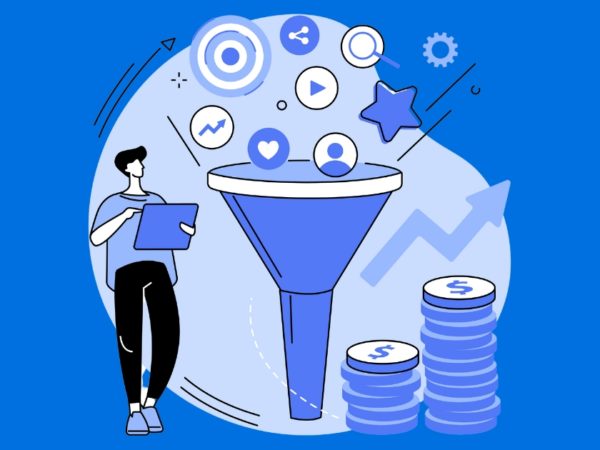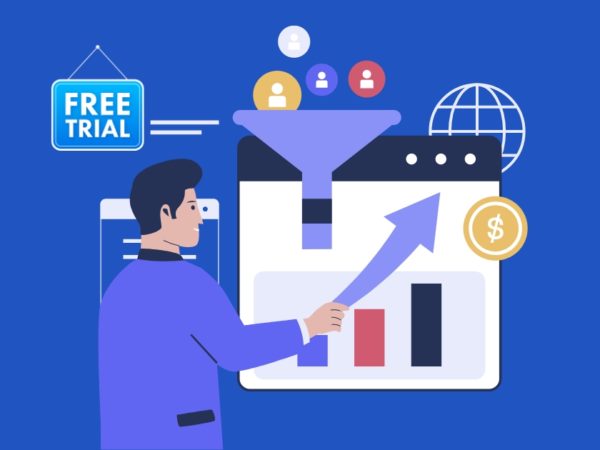<img alt="sales-intelligence-tools-geekflare" data- data-src="https://kirelos.com/wp-content/uploads/2023/08/echo/sales-intelligence-tools-geekflare.jpg/w=800" data- decoding="async" height="420" src="data:image/svg xml,” width=”800″>
Sales intelligence(SI) helps you discover the right customer or company, attract their attention, set up a trust-based business relationship, and close the deal.
It’d be nice if you could know which customers or businesses are looking for products or services you offer. Also, it’d be highly convenient if you’d known who’s the decision-making individual in a sales deal. Not to mention, if it’s you who reach out to the customer before everyone else is interested in closing the deal, then nothing like it!
You can easily achieve all the above if you can source the right data from the market. Here comes sales intelligence and advanced tools that offer such business insights from the open market.
If you’ve got the sales intelligence tools you need but still not seeing enough growth in sales revenue, read👀 this article through the end. Here, you’ll learn how to make use of SI to close deals efficiently!
What is Sales Intelligence?
<img alt="YouTube video" data-pin-nopin="true" data-src="https://kirelos.com/wp-content/uploads/2023/08/echo/maxresdefault.jpg64ef1f311ba82.jpg" height="720" nopin="nopin" src="data:image/svg xml,” width=”1280″>
A B2B salesperson utilizes many sales and marketing techniques to collect, study, and rank potential business customers. Additionally, salespeople also collect lead data using sales tactics to pitch them products and services. Not to mention, they also collect data on updated business names, owners, stakeholders, etc.
These diverse sales technologies have been brought under a broader subject known as sales intelligence. It deals with all kinds of data harvesting from the market that helps you close a sale faster than your competitors.
Mostly, the B2B sales and marketing team uses sales intelligence. It’s possible to use smart business data to drive sales because such data are already available on the internet, printed yellow pages, telephone directories, and so on.
Thanks to sales intelligence tools and solutions, your business’s sales process is often narrowed down to just a phone call or email to discuss the product or service.
How Does Sales Intelligence Differ from Business Intelligence?
Sales Intelligence (SI) is a part of business intelligence (BI) since it’s all about data analytics and visualization. While BI collects and analyzes data from all the departments of a business, SI only focuses on sales and marketing.
BI helps you to make data-driven decisions on business operations, HR, sales, marketing, finance, and many more. However, SI helps you pitch your products and services to the right buyer at the right time so you can increase the chances of winning deals.
Benefits of Sales Intelligence in Sales and Marketing
- SI helps you identify the most qualified leads. Thus, you can focus your time and resources on the ones most likely to convert.
- It can gather better customer-specific data than generalized data available on company websites. So, you can craft a personalized sales pitch that reflects the customer’s preferences.
- SI can also help you predict when a customer is more likely to buy. Thus, you can create a prospect calendar and accordingly contact your leads.
- Many SI tools can perform deep scans of the internet to discover topics and products your customers are interested in. Without SI, you would have invested multiple days’ worth of internet research.
- SI eliminates multiple steps from the sales cycle. You can close deals faster by contacting the right buyer at the right time.
Types of Sales Intelligence Data
The data collected during a SI drive comes from the following sources:
- Business profiles
- Social media profiles of people working in the business
- Procurement patterns
- Online or offline purchase intent data
- Public financial reports
- Social media handles
- Customer polls and surveys
- Analyzing competitors’ activities
Collected data can be classified into the following types:
#1. Psychographic Data
Such data includes behavioral and buying patterns of the customers or companies. You can understand their values, preferences, budget, buying periods, etc. If you know such data, you can personalize your sales pitch according to the client.
<img alt="YouTube video" data-pin-nopin="true" data-src="https://kirelos.com/wp-content/uploads/2023/08/echo/maxresdefault.jpg64ef1f312284b.jpg" height="720" nopin="nopin" src="data:image/svg xml,” width=”1280″>
#2. Organizational Data
Organizational data comprises details about a company’s structure, hierarchy, decision-making processes, and key personnel. It helps you to discover the decision-making individual in a business so you can directly talk to them.
#3. Technographic Data
This data includes software, servers, computing systems, etc., a company use for business operations. For example, TOYOTA uses Microsoft 365 as its workspace solution. If you know this, then you can approach TOYOTA to sell SharePoint migration services and SharePoint alternatives if they haven’t migrated to SharePoint Online already.
#4. Intent Data
Intent datasets of sales intelligence include keyword searches, Google searches, website visits, adding SaaS items to carts🛒, signing up for a free trial, requesting quotes, applying for demos, etc.
#5. Sales Triggers
These triggers often include mergers, leadership changes, funding announcements, or product launches. So, you know when the business will surely need services or products from your firm.
<img alt="YouTube video" data-pin-nopin="true" data-src="https://kirelos.com/wp-content/uploads/2023/08/echo/maxresdefault.jpg64ef1f3127bcb.jpg" height="720" nopin="nopin" src="data:image/svg xml,” width=”1280″>
Using SI for Account-Based and Lead-Based Selling
The best way to enhance sales is by adopting both account-based and lead-based selling. Here’s how SI can help:
Account-Based Selling
- SI shall identify the ideal account based on the industry, company size, revenue, location, and technology stack.
- Search the names of the accounts on SI tools to discover pain points, challenges, recent news, and key decision-makers.
- Create a personalized pitch highlighting customer pain points and how your products or services resolve those.
- Sales intelligence shall inform you about dynamic changes in the accounts’ interest in products by tracking website visits, social media feeds, etc.
Lead-Based Selling
- Score and rank the best leads based on factors like demographics, behavior, and engagement level.
- Monitor the online behavior of leads, such as website visits, content downloads, and email interactions.
- Market segmentation of your leads based on characteristics such as industry, job role, and interests.
- SI can help you understand the best times to reach out to leads.
How to Use Sales Intelligence to Close More Deals
Utilizing SI to boost the numbers of winning deal closures involves a multi-faceted approach, and these are as outlined below:
#1. Find the Market to Address
SI signals help pinpoint your target market by analyzing trends and demographics. This ensures your efforts are concentrated on those most likely to benefit, increasing deal-closure prospects.
Also, if you’re running online ads or creating affiliate programs for SaaS products, you’ll know which audience group you must target. Because targeting a broad audience is costly and doesn’t generate the return on investment (ROI) you want as compared to targetted advertisements.
#2. Learn Buying Signals
Identifying buying signals, like frequent website visits or engaging with content, is crucial. Timely responses to these signs guide potential customers toward a successful deal.
#3. Real-Time Intent Data on Buyers
Real-time intent data reveals prospects’ online activities, shaping tailored outreach. This knowledge makes interactions more pertinent and valuable. Also, you can avoid those uncomfortable sales calls.
#4. Integrate With In-House CRM
Seamlessly integrating sales intelligence with your CRM makes insights easily accessible to your sales team. This promotes informed conversations and personalization.
Also, you can create personalized sales pitches and customized brochures and keep them in dedicated sales accounts. These are only possible when you integrate SI tools with business apps like workspaces, cloud storage, and CRMs.
#5. Expand Existing Database
Enrich your database with extra lead info, like job titles, company details, and recent news. A richer database enables more precise targeting.
#6. Create a Killer Sales Strategy
Leverage sales intelligence to refine your sales tactics based on historical data, predictive analytics, AI-based forecasting, and so on. A tailored strategy increases the likelihood of closing winning deals.
#7. Improve Customer Experience of Sales
Utilizing SI insights, your sales team can have a fruitful conversation with the buyers. It’s possible to analyze the market to explore the issues the buyer is facing. Then, create a solution pitch and present that to the customer.
Also, make the sales process as intelligent and informed as possible to avoid disagreements with the client. Not to mention, proactive set up of demo sessions, extensive support in setting up the tools, also add to sales experience enhancements.
Also read: Freshchat: A Tool to Elevate Your Customer Experience
How to Use SI to Accelerate B2B Sales Process
#1. Draft an Ideal Customer Profile (ICP)
An ideal customer profile is a strategic framework that outlines the characteristics, attributes, and traits of the perfect customer for your product or service. It’s also an indication that the leads or prospects falling within the ICP should convert more easily than random leads.
Instead of wasting time on random leads, you must invest in creating a ranked list of ICPs. Then, leverage SI to make contact with the leads to persuade them to close the deal.
To kickstart your efforts, create a comprehensive Ideal Customer Profile (ICP) using insights from sales intelligence. Dive into your existing customer data and leverage SI programs to extract valuable demographic information and industry trends.
By meticulously outlining your ideal customer, you can laser-focus your sales efforts on those most likely to convert. This not only saves time and resources but also ensures that your team is engaging with prospects who fit your solution perfectly.
#2. Leads Qualification and Ranking
Whether you’re a small SaaS software developer or a large B2B wholesale marketplace selling business equipment, your leads database will be enormous. On top of that, if there are few sales representatives, you must assign them leads and prospects for sales calls.
You must choose leads that are ready to buy in a week or so, probably would order a big lot, and ultimately, the revenue figure is staggering. Manually picking such leads from a database of tens of thousands of prospects is next to impossible. Here comes leads qualifying and ranking using sales intelligence data.
SI helps you to qualify, and rank leads based on company size, market cap, the recent history of buying, major pain points, recent investments, etc., data. This is a systematic way of leading management. It enables your sales team to concentrate their efforts where they are most likely to yield results.
#3. Tailored Outreach Programs
Personalization is the key to effective B2B sales, and sales intelligence provides the insights needed to create personalized outreach programs, content, brochures, pitch decks, etc.
You must utilize the wealth of data gathered from SI to craft targeted messages that address specific pain points, aspirations, and challenges of your leads. This level of customization not only captures their attention but also establishes your credibility as a solution provider.
You can also use this tactic to produce personalized online advertisements if you’re planning to run pay-per-click ad campaigns.
Remember, your competitors may try to fail or overbudget your PPC campaigns by using click frauds, so you need to know how to protect your PPC campaigns.
#4. Identify Sales Triggers
SI helps you discover numerous sales triggers that indicate the lead is ready to buy software, hardware, or raw materials for the business. Advanced sales intelligence software will rank leads on hundreds of such triggers as named below:
- New public or private events
- New apps, websites, or marketplaces
- Looking for new marketing channels
- New executives onboarded recently
- The lead announced new products, services, or geographic launches
- Financial reports
As soon as your SI tools indicate such activities, you must appoint a sales representative to make contact and pitch your value proposition.
#5. Determine Improvement Opportunities
You must regularly audit the data provided by SI tools to identify areas for improvement in the sales process. This should be analyzing conversion rates at different stages, identifying bottlenecks, or pinpointing areas where leads are dropping off. Modify your approach based on these insights to optimize your sales process for better success rates.
Sales Intelligence—The Future Trend
According to Allied Market Research, the global SI market revenue should be $7.35 billion by 2030. It’s a 10.6% CAGR from $2.78 billion in 2020. Most of the investments in this sales technology will be in the following niches in the upcoming years:
- Artificial intelligence (AI) driven market research, prospecting, pitching, and selling.
- Extensive use of machine learning algorithms to create data-driven insights from raw data and texts.
- Sales and marketing departments invest heavily in employee training and upskilling.
- Adoption of predictive analysis so that salespersons can proactively address the issues of their leads and prospects.
- Businesses will heavily invest in expanding sales channels to all digital platforms and use tools to automate lead generation, lead ranking, etc.
- Increasing global regulations on customer data will push sales intelligence solutions providers to integrate data security and privacy into their products.
Next up, read about the best sales forecasting software for near-accurate projections.



